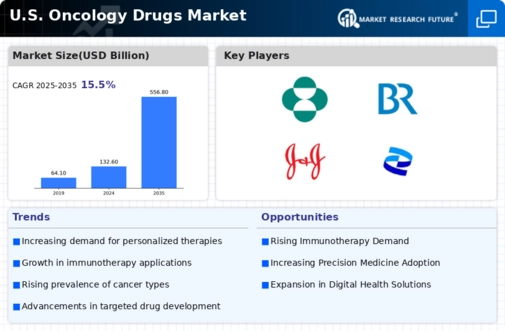Growing Cancer Incidence
The market is experiencing a notable surge due to the increasing incidence of cancer in the United States. According to the American Cancer Society, approximately 1.9 million new cancer cases are expected to be diagnosed in 2025. This rising trend in cancer cases necessitates the development and availability of effective oncology drugs, thereby driving market growth. The market is likely to expand as healthcare providers seek innovative treatments to address this growing patient population. Furthermore, the aging population, which is more susceptible to various cancers, contributes to this upward trajectory. As a result, pharmaceutical companies are focusing on research and development to create targeted therapies and immunotherapies, which are anticipated to dominate the oncology drugs market in the coming years.
Emerging Biotech Companies
The oncology drugs market is witnessing a surge in the number of emerging biotech companies focused on developing innovative cancer therapies. These companies are often at the forefront of research, utilizing cutting-edge technologies such as gene editing and artificial intelligence to create novel treatments. The presence of these startups fosters a competitive landscape, driving established pharmaceutical companies to enhance their research and development efforts. In 2025, the oncology drugs market is likely to benefit from the influx of new entrants, which may lead to breakthroughs in treatment options. Furthermore, collaborations between biotech firms and larger pharmaceutical companies are becoming increasingly common, facilitating the sharing of resources and expertise, ultimately accelerating the development of effective oncology drugs.
Increased Healthcare Expenditure
The oncology drugs market is positively impacted by the rising healthcare expenditure in the United States. As healthcare spending continues to grow, more resources are allocated towards cancer treatment and research. According to the Centers for Medicare & Medicaid Services, national health expenditure is projected to reach $6.2 trillion by 2028, with a significant portion dedicated to oncology. This increase in funding allows for the development of new oncology drugs and the expansion of treatment options available to patients. Additionally, higher healthcare spending facilitates access to advanced therapies, which may lead to improved patient outcomes. Consequently, The market is expected to thrive as financial resources become more readily available for cancer care.
Advancements in Precision Medicine
The oncology drugs market is significantly influenced by advancements in precision medicine, which tailors treatment based on individual patient characteristics. This approach has gained traction in recent years, leading to the development of targeted therapies that are more effective and have fewer side effects. The National Cancer Institute indicates that precision medicine has the potential to improve treatment outcomes for patients with specific genetic mutations. As a result, pharmaceutical companies are investing heavily in research to identify biomarkers and develop drugs that can specifically target these mutations. This trend is expected to enhance the oncology drugs market, as more personalized treatment options become available, ultimately improving patient survival rates and quality of life.
Regulatory Support for Drug Approvals
The oncology drugs market benefits from robust regulatory support aimed at expediting the approval process for new cancer therapies. The U.S. Food and Drug Administration (FDA) has implemented various initiatives, such as the Breakthrough Therapy designation, which allows for faster development and review of drugs that show promise in treating serious conditions. This regulatory environment encourages pharmaceutical companies to invest in oncology drug development, as they can bring innovative treatments to market more quickly. In 2025, the oncology drugs market is likely to see an influx of new therapies, as the FDA continues to prioritize cancer treatments. This supportive framework not only fosters innovation but also enhances patient access to potentially life-saving medications.















Leave a Comment